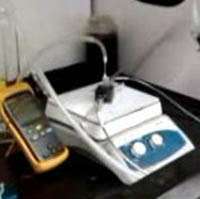Diabetes Sensor simulation using standard lab equipment.
Through the efforts and successes of University of Cincinnati researchers, we will one day live in a world with inexpensive, portable detection devices for home use. The application of direct concern now is a device to detect diabetes without drawing a single drop of blood. Thanks to Anastasios Angelopoulos, associate professor in the School of Energy, Environmental, Biological, and Medical Engineering (SEEBME), and his team of colleagues and students at UC's College of Engineering and Applied Science, one day soon, diabetics will simply exhale into a small, hand-held device that detects and measures acetone in their breath. Acetone is proving itself to be a positive indicator of blood glucose levels.
Angelopoulos and doctoral student Adam Worrall recently presented their work titled “Real Time Optical Detection of Medical Biomarkers and Hazardous Materials Utilizing Polymer Catalyst Membranes” at the Ohio Innovation Sensor Summit in Dayton, Ohio. This annual summit serves to provide opportunities for companies to explore new concepts as well as their marketability. Angelopoulos' collaborators on this work include Jonathan A. Bernstein, MD, UC College of Medicine clinic professor, and Doug McClelland, president of Mound Technical Solutions in Miamisburg, Ohio.
The team’s research focuses on developing an inexpensive, portable detection device to detect gaseous biomarkers and hazards. Existing detection methods are typically bulky and time intensive, limiting the ability to detect such materials in the home, office or workplace. Angelopoulos aims to make the method yield instant results, as a real-time device. The researchers have recently made giant strides toward such a novel tool.
Angelopoulos and his team have created a method for the detection of low concentrations of harmful compounds (volatile organic compounds) in the body. This approach uses perfluorosulfonic acid (PSA) polymer membranes as a catalyst that shows color-coded chemical results, called chemselective colorimetric reactions.
These results are ideal for an individual to use at home as they are simple to read and understand. The less intense the color- the lower the blood glucose levels and the greater the color intensity means that blood glucose levels are elevated. Angelopoulos plans to make a color intensity chart for users to identify their specific levels of blood glucose based on the catalyzed color.
PSA ionomers have been found to work well in the detection of acetone, formaldehyde and various anhydrides in the presence of resorcinol. Through the use of visible light spectroscopy, researchers can selectively detect unique products formed by the reactions. This allows them to determine how much exposure an individual has experienced. Of particular interest to the team is the detection of acetone in human breath as the basis for a revolutionary blood glucose monitor.
Angelopoulos and his team have run into a few obstacles. Chief among these is water. Water is the largest single compound in human breath and interferes with acetone measurement as it readily absorbs into the PSA polymer membrane that is acting as the catalyst. This absorption causes swelling and interferes with the optically sensitive results. The researchers hope to solve this problem by altering the PSA membrane to limit the effects of humidity on the reaction.
Although their research is ground-breaking, commercializing the team’s palm-sized, portable blood glucose monitor is several years off. Satisfying rigorous FDA regulations and extensive clinical testing are needed before commercialization can be realized.
Their discovery of the PSA polymer as a catalyst has opened a wide range of applications and what follows is seemingly limitless. “We have created a platform technology that is truly novel,” Angelopoulos reflects.
Provided by University of Cincinnati






















